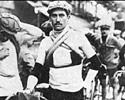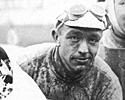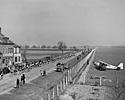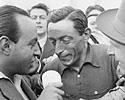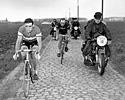
Recently on Cyclingnews.com |
Tales from the peloton, April 18, 2006
The real Hell of the North
Paris-Roubaix is famously known as the Hell of the North. But as Les Woodland tells, the name doesn't come from its notoriously awful stretches of cobbles but from the far darker days of the early 20th century.
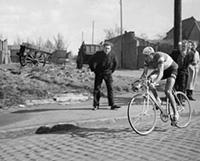
|
"Hell of the North". Great phrase, isn't it? It sums up Paris-Roubaix perfectly. But if you think it means the cobbles that turn the race into what Jacques Goddet called "the last great folly of cycle-racing", I'm afraid you're wrong.
"Hell of the North" dates back to the days when pavé was everywhere. If Paris-Roubaix went over cobbles, nobody thought it astonishing. Most roads weren't sur-faced at all so, far from being bad, cobbles were as good as they got. Even if they were bumpy on a bike, at least there was usually smooth, compressed ash alongside. Why describe good roads as "hell"?
So what does it mean? Well, I'll tell you, but hold your horses. First some background to put it all in perspective.
These days the race ought to be called Paris-Lille. Roubaix has become just an industrial suburb of a larger city. And it still hasn't got a lot going for it. The best you can say is that Lille's other satellite towns are equally unpleasant. The region's big-chimney businesses have long failed and never been properly replaced. Nearly one in five adults is out of a job.
|
|
|
|
|
|
|
|
|
|
|
|
Sadly, Roubaix's identity problem goes right back to the 1890s, when it and Lille were quite distinct. It was up by the Belgian border and, so far as the fat cats and politicians of distant Paris were concerned, it might as well have been in Norway. And that was bad for business. The town needed a better press.
Two mill owners, Théo Vienne and Maurice Pérez, were prepared to do some-thing about it. They were bike fans, they ran Sunday races on the old track at Croix and they were fans of Bordeaux-Paris, which had started in 1891. No chance they could hope to rival that, so they wrote to Le Vélo, the sports paper which ran it, and said they were sure they wanted their riders to be in peak condition so why not hold a training race from the paper's offices in Paris to their home city of Roubaix? If big races also fin-ished outside the capital, it would get more people buying the organisers' paper.
Plus, the mill owners knew very well, it would be good for Roubaix's trade and for their own businesses along with it.
The director who read the letter was called Paul Rousseau. And he agreed. And he got out a map and worked out a route and sent two officials out in a big Panhard car to have a look. One them was Victor Breyer, the man who stood on the Tourmalet in 1910 when the Tour crossed it for the first time and for his troubles got called a murderer by one of the riders.
Breyer drove to Amiens in the Panhard, which he loved, then got out and cy-cled the rest of the way. That bit he loved rather less. He got to Roubaix so cold, miserable and coated in mud that he wanted the race called off. Only a shower and a good meal changed his mind.
The riders weren't impressed by what they'd heard either and half of them stayed in bed, including a young Henri Desgrange, first organiser of the Tour de France. The others set off behind their pacers for a day of incident. The Welshman Arthur Linton, for instance, hit a dog and crashed for the first of six times; Josef Fischer got a 23-minute lead, was nearly knocked off by a horse and was eventually halted by cows.
The crowd at Roubaix followed all this through telegrams sent from post of-fices along the route. They knew their new race was hard but they were aghast nevertheless to see Fischer win splattered in filth and blood. Only four others finished within an hour, all with congealed blood on their arms, legs or faces. But hell though it was, it wasn't yet the Hell of the North.
That phrase dates from 1919. By then, Roubaix and northern France were dev-astated by years of static war. Nine million had died and more from France than any other nation. Further south, news from the war zone was scant. Communications were down. Sure, there could be another race. But who knew if there was still a road to Roubaix? More than that, was Roubaix still there? So in 1919 the organisers drove off to look.
At first all appeared well. There was destruction and misery, yes, and a strange shortage of men, but the country had survived. You can imagine the restrained relief in the little exploratory party. But suddenly things changed. The air began to reek of sewage and rotting cattle. Trees became blackened, ragged stumps. Everywhere was mud.
To describe it as "hell" was the only word. The little party had seen the hell of the north - in this particular case, the French administrative region of the North in which Roubaix stands. And that's how they reported it in their papers next day.
But hell was the post-war condition, not the state of the roads. Nobody thought the roads were hellish because that's just how roads were. But come 1944 and liberation from the second world war, recovery brought better, smoother and straighter roads. And something curious happened. Just as in the Tour of Flanders, people began grew nostalgic for the bad old days. What was the point of Paris-Roubaix if all it had were fine, restored highways?
People wanted drama and heroes, men like world champion Georges Ronsse who in 1929 had shouldered his broken bike to run to the line.
And so the organisers picked out the cart tracks that were all that remained of how things were, and they picked them out so determinedly that in 1952 one town mayor protested, "Why do you bring us this terrible publicity?" before going out and surfacing the road concerned to stop the wretched race coming his way again.
Well, now Paris-Roubaix and its appalling roads are legend. They were this year, as ever, what Goddet said they were: the last folly of cycling. But it's worth remem-bering that while we now think of the Hell of the North as the devil's roads of backbreak-ing cobbles, that's only sport. What Hell of the North actually refers to are the millions of lives ended or ruined by the most murderous war man has ever seen. And that's a sobering thought.

